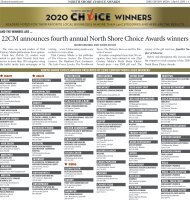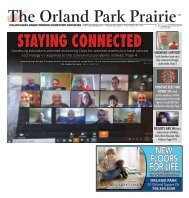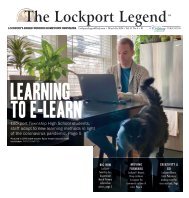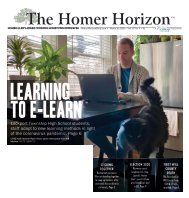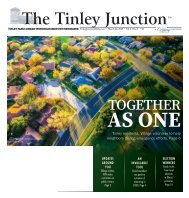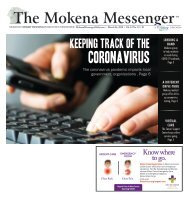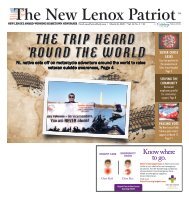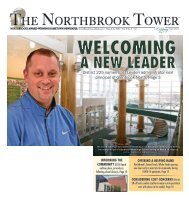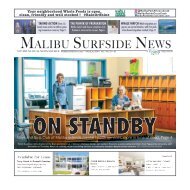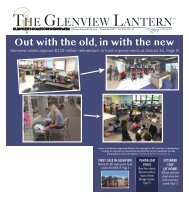MSN_071918
You also want an ePaper? Increase the reach of your titles
YUMPU automatically turns print PDFs into web optimized ePapers that Google loves.
malibusurfsidenews.com news<br />
Malibu surfside news | July 19, 2018 | 5<br />
Keeping the past close to home<br />
Reflections of<br />
Malibu’s history live<br />
on in Pepperdine<br />
archive collections<br />
Suzanne Guldimann<br />
Freelance Reporter<br />
Ephemera, printed material<br />
like matchbooks and<br />
postcards designed for<br />
limited service have become<br />
a hot collectable in<br />
recent decades, but these<br />
items are more than that:<br />
They open a window into<br />
the past, offering researchers<br />
a fascinating perspective<br />
on the minutiae of everyday<br />
life.<br />
Melissa Nykanen, associate<br />
university librarian<br />
for special collections<br />
and university archives at<br />
Pepperdine University, describes<br />
it as a way to “expand<br />
history.”<br />
“Ephemera is increasingly<br />
important,” Nykanen<br />
explained at a July 10<br />
community presentation at<br />
the Malibu Library.<br />
Nykanen and Kelsey<br />
Knox, the archivist for<br />
the collection, brought a<br />
selection of Pepperdine’s<br />
ephemera to the talk entitled<br />
“Local History: Malibu<br />
Postcards, Menus and<br />
Matchbooks.”<br />
In addition to discussing<br />
the items, they encouraged<br />
event participants to join<br />
the conversation and take a<br />
closer look at the everyday<br />
objects that can hold so<br />
many clues about the past.<br />
Pepperdine University<br />
libraries’ holdings include<br />
rare books and a film and<br />
television archive, but they<br />
also include the Malibu Historical<br />
Archive, an umbrella<br />
title for a diverse assortment<br />
of smaller collections that<br />
range from local newspapers<br />
and archival photos, to<br />
real estate brochures, postcards,<br />
matchbooks, event<br />
tickets and programs, and<br />
even drink coasters and<br />
cocktail napkins.<br />
The objects Nykanen<br />
and Knox selected for<br />
the event included tickets<br />
from the 1984 Los Angeles<br />
Olympics water polo venue<br />
at Pepperdine; a phone<br />
directory from the 1950s; a<br />
matchbook from Top o’ the<br />
Sea, the first restaurant on<br />
the Malibu Pier; and one<br />
from Alice’s Restaurant,<br />
which occupied the turretlike<br />
gatehouse building<br />
from 1972-1995.<br />
Nykanen explained that<br />
ephemera can offer insight<br />
into aspects of everyday<br />
life that could be almost<br />
impossible to find in more<br />
traditional archival materials<br />
like newspapers. She<br />
pointed to how menus can<br />
reveal food trends and economic<br />
data — allowing<br />
researchers to track everything<br />
from when items<br />
like fresh coffee or apple<br />
pie become popular menu<br />
items, to the availability<br />
and price of oysters over<br />
time.<br />
The postcards presented<br />
at the talk offer a snapshot<br />
of architecture, cars and<br />
even clothing.<br />
Some also provide a<br />
glimpse of lost landmarks.<br />
One such postcard of Malibu<br />
Pier from the late 1940s<br />
shows the wall decorated<br />
with Malibu Potteries tiles<br />
that once extended from<br />
the Adamson House to the<br />
pier. Only the section immediately<br />
adjacent to the<br />
house and beach parking<br />
lot survives today.<br />
Another postcard of the<br />
pier, this time from the<br />
late 1950s, showed the<br />
sports fishing boat Lenbrooke,<br />
much to the delight<br />
of audience member<br />
Pete Haynes, who used to<br />
captain the boat as a young<br />
man.<br />
Haynes provided background<br />
information on another<br />
item of ephemera, a<br />
pair of tickets sold at the<br />
pier for bait.<br />
“Each anchovy was five<br />
cents,” he recalled.<br />
Postcards of the Las<br />
Flores Inn revealed its evolution<br />
from 1915, when it<br />
provided refreshments like<br />
ice cream to early motorists<br />
hoping for a glimpse<br />
of the famed Malibu Rancho,<br />
off limits to anyone<br />
without ranch business, to<br />
the mid-century modern<br />
Sea Lion — boasting the<br />
“longest oceanfront dining<br />
room in the world,” and a<br />
tank with the restaurant’s<br />
captive sea lion.<br />
“Her name was Josephine,”<br />
a member of the<br />
audience volunteered.<br />
The Sea Lion and Lenbrooke<br />
postcards weren’t<br />
the only items that generated<br />
discussion. Haynes<br />
and his childhood friend<br />
Jim McHenry used a 1950s<br />
Malibu phone directory to<br />
look up their old phone<br />
numbers — just four digits<br />
in those days, without<br />
a three-number prefix, or<br />
area code.<br />
McHenry, who grew<br />
up in western Malibu, described<br />
his neighborhood’s<br />
“party line,” a single phone<br />
line loop that served multiple<br />
families, and could<br />
only be used when another<br />
LIVE THE LIFE YOU WERE ALWAYS MEANT TO LIVE<br />
neighbor wasn’t chatting.<br />
“We love to talk with our<br />
donors and the people in<br />
the community [about the<br />
objects in the collection],”<br />
Nykanen said, adding that<br />
personal recollections like<br />
THE INDUSTRY’S FINEST HIGH-END LUXURY<br />
ADDICTION TREATMENT FACILITY<br />
800.501.1988<br />
CLIFFSIDEMALIBU.COM<br />
Sport fishing boat Lenbrooke returns to Malibu Pier in<br />
the 1950s. The boat took passengers out for half-day and<br />
full-day fishing trips from the end of the pier. From the<br />
Eric Wienberg Collection, Pepperdine Libraries Special<br />
Collections and Archives<br />
Please see history, 10









